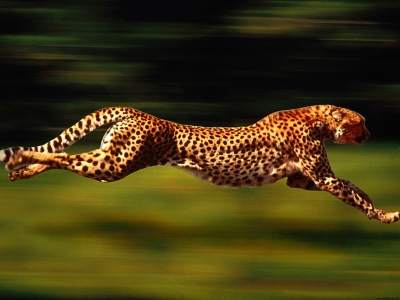 Today's post was written by Albert Greenhut of Engineered Materials, Inc.
Today's post was written by Albert Greenhut of Engineered Materials, Inc.
What do little kids like? Loud horns, big locomotives, fast airplanes, cool cars, etc.
Anything that is big or fast or strong that pushes the limits of our imagination appeals to the inner child in all of us, some of us even let this inner child run wild and can truly enjoy “big boy toys”. That same philosophy applies to when you ask a child what their favorite animal is. You usually hear something like an elephant because it’s enormous, a shark because it’s scary, or a cheetah because it is fast.
That feeling never fades; we are drawn to what pushes the limits. I have been fortunate enough to be up close and personal with a cheetah. I usually consider myself well informed, but I knew very little about this creature other than its sheer overwhelming speed. Appropriately enough in order to achieve such incredible speeds the cheetah’s entire design revolves around its overpowering main feature, and therefore there isn’t much else to know. The cheetah has a small head, a flat rib cage, long slender legs, a long rudder of a tail, hard paws, and large nostrils. Most of what defines a cheetah physically relates back to one thing: speed. It is a model engineering feat because it accomplishes things that we cannot engineer machines to do; namely this animal can accelerate faster than a Ferrari.
Now that we have discussed the superiority of the design features of the ultimate interceptor let’s talk about Intercept. Packaging has one main goal, to preserve the integrity of the product during transit and storage. This can mean protecting from, and not limited to, physical harm, water damage, and corrosion. Intercept has been designed to protect products from physical harm and ESD damage, but it’s true superiority comes from succeeding where many others fall short: corrosion protection. Intercept differs from a cheetah in that it does not have a unique set of visual characteristics; it appears similar to polyethylene plastic, but its ingenuity lies within. The material has a special copper reacted into it, that blocks corrosive gasses from the outside neutralizes any that may have been trapped inside.
Both of these interceptors are feats of specially applied engineering, but only one can be delivered around the world in various forms, per customer requirements. The Intercept Technology Group is committed to increasing the awareness of the fragile environmental world and working towards protecting its truly unique wildlife and plant life. Intercept Technology, good for your products, gentle on the environment.
Cheetah image from Goodheart's Extreme Science

Intercept Technology Packaging products fit within a sustainability strategy because they are reusable, recyclable, do not contain or use volatile components (No VOCs, Not a VCI) and leave a smaller carbon footprint than most traditional protective packaging products.
Liberty Intercept Blog
Intercept Packaging Meets Interceptor
Posted by Elaine Spitz on May 8, 2012 10:08:00 AM
What do little kids like? Loud horns, big locomotives, fast airplanes, cool cars, etc.
Anything that is big or fast or strong that pushes the limits of our imagination appeals to the inner child in all of us, some of us even let this inner child run wild and can truly enjoy “big boy toys”. That same philosophy applies to when you ask a child what their favorite animal is. You usually hear something like an elephant because it’s enormous, a shark because it’s scary, or a cheetah because it is fast.
That feeling never fades; we are drawn to what pushes the limits. I have been fortunate enough to be up close and personal with a cheetah. I usually consider myself well informed, but I knew very little about this creature other than its sheer overwhelming speed. Appropriately enough in order to achieve such incredible speeds the cheetah’s entire design revolves around its overpowering main feature, and therefore there isn’t much else to know. The cheetah has a small head, a flat rib cage, long slender legs, a long rudder of a tail, hard paws, and large nostrils. Most of what defines a cheetah physically relates back to one thing: speed. It is a model engineering feat because it accomplishes things that we cannot engineer machines to do; namely this animal can accelerate faster than a Ferrari.
Now that we have discussed the superiority of the design features of the ultimate interceptor let’s talk about Intercept. Packaging has one main goal, to preserve the integrity of the product during transit and storage. This can mean protecting from, and not limited to, physical harm, water damage, and corrosion. Intercept has been designed to protect products from physical harm and ESD damage, but it’s true superiority comes from succeeding where many others fall short: corrosion protection. Intercept differs from a cheetah in that it does not have a unique set of visual characteristics; it appears similar to polyethylene plastic, but its ingenuity lies within. The material has a special copper reacted into it, that blocks corrosive gasses from the outside neutralizes any that may have been trapped inside.
Both of these interceptors are feats of specially applied engineering, but only one can be delivered around the world in various forms, per customer requirements. The Intercept Technology Group is committed to increasing the awareness of the fragile environmental world and working towards protecting its truly unique wildlife and plant life. Intercept Technology, good for your products, gentle on the environment.
Cheetah image from Goodheart's Extreme Science
Intercept Technology Packaging products fit within a sustainability strategy because they are reusable, recyclable, do not contain or use volatile components (No VOCs, Not a VCI) and leave a smaller carbon footprint than most traditional protective packaging products.
Topics: how to reduce packaging waste, anti-corrosion barrier packaging, corrosion prevention, sustainable packaging
Related Posts
Engineered to Recycle - Waste Not
5 Recycling Problems that Industry Can Help Solve
Total Cost Assessment - Case Studies
Leave a Comment